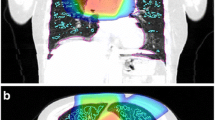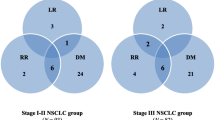Abstract
Purpose
To develop a multi-variate risk model of lung complication for the treatment of locally advanced lung cancer combining radiation dosimetry and patient-specific risk factors including chronic obstructive pulmonary disease (COPD).
Materials/methods
A retrospective study of 89 advanced lung cancer patients including clinical variables and radiation dose-volume metrics was correlated to overall survival (OS), local progression-free survival (LPFS), and lung complications. Lung toxicities were defined as grade 2 or higher lung complication including persistent cough requiring narcotic or antitussive agents, and dyspnea with minimal effort but not at rest. Grade 2 or higher radiation pneumonitis (RP) was defined clinically or radiographically. Each observed complication was correlated to the set of patient-specific factors via regression.
Results
Age was the dominant factor in survival analysis; in patients > 70, 2-year survival was 28% (N = 18) vs. 59% in patients < 70 (N = 71, HR = 3.9, p = 0.004). OS and LPFS were not significantly different based on with COPD status (p = 0.2, HR = 1.5) or radiation dose (range 40–74 Gy, median = 60 Gy, p > 0.5, HR < 1.3). In predicting all observed lung complications, multi-variate stepwise logistic regression revealed COPD status (p = 0.01) and a total lung V50 (p = 0.02) as significant. Separation of G2 or higher lung complication and RP showed a different trend, with G2 or higher lung complication statistically associated with age (p = 0.02) and COPD (p = 0.03). Radiation pneumonitis was only associated with total lung volume at 20 Gy (V20, p = 0.003), with a resulting model risk (RP) = 1.4 (V20-0.21).
Conclusions
COPD status was not associated with survival or radiation pneumonitis. Age was the dominant factor in survival, and total lung V20 was associated with risk of RP.




Similar content being viewed by others
References
Marks LB, Bentzen SM, Deasy JO, Kong FM(S), Bradley JD, Vogelius IS, el Naqa I, Hubbs JL, Lebesque JV, Timmerman RD, Martel MK, Jackson A (2010) Radiation dose–volume effects in the lung. Int J Radiat Oncol Biol Phys 76:S70–S76
Seppenwoolde Y, Lebesque JV, de Jaeger K, Belderbos JSA, Boersma LJ, Schilstra C, Henning GT, Hayman JA, Martel MK, ten Haken RK (2003) Comparing different NTCP models that predict the incidence of radiation pneumonitis. Int J Radiat Oncol Biol Phys 55:724–735
Hope AJ, Lindsay PE, el Naqa I, Alaly JR, Vicic M, Bradley JD, Deasy JO (2006) Modeling radiation pneumonitis risk with clinical, dosimetric, and spatial parameters. Int J Radiat Oncol Biol Phys 65:112–124
Semenenko VA, Li XA (2008) Lyman–Kutcher–Burman NTCP model parameters for radiation pneumonitis and xerostomia based on combined analysis of published clinical data. Phys Med Biol 53:737–755
Tucker SL, Liu HH, Liao Z, Wei X, Wang S, Jin H, Komaki R, Martel MK, Mohan R (2008) Analysis of radiation pneumonitis risk using a generalized Lyman model. Int J Radiat Oncol Biol Phys 72:568–574
Tucker SL, Xu T, Paganetti H, Deist T, Verma V, Choi N, Mohan R, Liao Z (2019) Validation of effective dose as a better predictor of radiation pneumonitis risk than mean lung dose: secondary analysis of a randomized trial. Int J Radiat Oncol Biol Phys 103:403–410
Palma DA, Senan S, Tsujino K, Barriger RB, Rengan R, Moreno M, Bradley JD, Kim TH, Ramella S, Marks LB, de Petris L, Stitt L, Rodrigues G (2013) Predicting radiation pneumonitis after chemoradiation therapy for lung cancer: an international individual patient data meta-analysis. Int J Radiat Oncol Biol Phys 85:444–450
Decramer M, Rennard S, Troosters T, Mapel DW, Giardino N, Mannino D, Wouters E, Sethi S, Cooper CB (2008) COPD as a lung disease with systemic consequences – clinical impact, mechanisms, and potential for early intervention. COPD: J Chron Obstruct Pulmon Dis 5:235–256
Kong F-M, Wang S (2015) Non-dosimetric risk factors for radiation-induced lung toxicity. Semin Radiat Oncol 25:100–109
Kimura T, Togami T, Takashima H, Nishiyama Y, Ohkawa M, Nagata Y (2012) Radiation pneumonitis in patients with lung and mediastinal tumours: a retrospective study of risk factors focused on pulmonary emphysema. Br J Radiol 85:135–141
Rancati T, Ceresoli GL, Gagliardi G, Schipani S, Cattaneo GM (2003) Factors predicting radiation pneumonitis in lung cancer patients: a retrospective study. Radiother Oncol 67:275–283
Shi A, Zhu G, Wu H, Yu R, Li F, Xu B (2010) Analysis of clinical and dosimetric factors associated with severe acute radiation pneumonitis in patients with locally advanced non-small cell lung cancer treated with concurrent chemotherapy and intensity-modulated radiotherapy. Radiat Oncol 5:35
Jin H, Tucker SL, Liu HH, Wei X, Yom SS, Wang S, Komaki R, Chen Y, Martel MK, Mohan R, Cox JD, Liao Z (2009) Dose-volume thresholds and smoking status for the risk of treatment-related pneumonitis in inoperable non-small cell lung cancer treated with definitive radiotherapy. Radiother Oncol 91:427–432
Kocak Z, Evans ES, Zhou SM, Miller KL, Folz RJ, Shafman TD, Marks LB (2005) Challenges in defining radiation pneumonitis in patients with lung cancer. Int J Radiat Oncol Biol Phys 62:635–638
RTOG/EORTC Late Radiation Morbidity Scoring Schema. Available at: https://www.rtog.org/ResearchAssociates/AdverseEventReporting/RTOGEORTCLateRadiationMorbidityScoringSchema.aspx. Accessed 20th July 2016
Common Terminology Criteria for Adverse Events (CTCAE) (2017) 155
Yorke ED, Jackson A, Rosenzweig KE, Merrick SA, Gabrys D, Venkatraman ES, Burman CM, Leibel SA, Ling CC (2002) Dose-volume factors contributing to the incidence of radiation pneumonitis in non-small-cell lung cancer patients treated with three-dimensional conformal radiation therapy. Int J Radiat Oncol Biol Phys 54:329–339
Fay M, Tan A, Fisher R, Mac Manus M, Wirth A, Ball D (2005) Dose-volume histogram analysis as predictor of radiation pneumonitis in primary lung cancer patients treated with radiotherapy. Int J Radiat Oncol Biol Phys 61:1355–1363
Roeder F, Friedrich J, Timke C, Kappes J, Huber P, Krempien R, Debus J, Bischof M (2010) Correlation of patient-related factors and dose-volume histogram parameters with the onset of radiation pneumonitis in patients with small cell lung cancer. Strahlenther Onkol 186:149–156
Mehta V (2005) Radiation pneumonitis and pulmonary fibrosis in non–small-cell lung cancer: pulmonary function, prediction, and prevention. Int J Radiat Oncol Biol Phys 63:5–24
Ghafoori P, Marks LB, Vujaskovic Z, Kelsey CR (2008) Radiation-induced lung injury. Assessment, management, and prevention. Oncology (Williston Park, NY) 22:37–47; discussion 52-53
Graham MV, Purdy JA, Emami B, Harms W, Bosch W, Lockett MA, Perez CA (1999) Clinical dose-volume histogram analysis for pneumonitis after 3D treatment for non-small cell lung cancer (NSCLC). Int J Radiat Oncol Biol Phys 45:323–329
Kim TH, Cho KH, Pyo HR, Lee JS, Zo JI, Lee DH, Lee JM, Kim HY, Hwangbo B, Park SY, Kim JY, Shin KH, Kim DY (2005) Dose-volumetric parameters for predicting severe radiation pneumonitis after three-dimensional conformal radiation therapy for lung cancer. Radiology 235:208–215
Sekine Y, Behnia M, Fujisawa T (2002) Impact of COPD on pulmonary complications and on long-term survival of patients undergoing surgery for NSCLC. Lung Cancer 37:95–101
Wong DH et al (1995) Factors associated with postoperative pulmonary complications in patients with severe chronic obstructive pulmonary disease. Anesth Analg 80:276–284
Sekine Y, Kesler KA, Behnia M, Brooks-Brunn JA, Sekine E, Brown JW (2001) COPD may increase the incidence of refractory supraventricular arrhythmias following pulmonary resection for non-small cell lung cancer. Chest 120:1783–1790
Moreno M, Aristu J, Ramos LI, Arbea L, López-Picazo JM, Cambeiro M, Martínez-Monge R (2007) Predictive factors for radiation-induced pulmonary toxicity after three-dimensional conformal chemoradiation in locally advanced non-small-cell lung cancer. Clin Transl Oncol 9:596–602
Takeda A, Kunieda E, Ohashi T, Aoki Y, Oku Y, Enomoto T, Nomura K, Sugiura M (2012) Severe COPD is correlated with mild radiation pneumonitis following stereotactic body radiotherapy. Chest 141:858–866
Inoue T, Shiomi H, Oh R-J (2015) Stereotactic body radiotherapy for stage I lung cancer with chronic obstructive pulmonary disease: special reference to survival and radiation-induced pneumonitis. J Radiat Res 56:727–734
Vestbo J, Hurd SS, Agustí AG, Jones PW, Vogelmeier C, Anzueto A, Barnes PJ, Fabbri LM, Martinez FJ, Nishimura M, Stockley RA, Sin DD, Rodriguez-Roisin R (2013) Global strategy for the diagnosis, management, and prevention of chronic obstructive pulmonary disease: GOLD executive summary. Am J Respir Crit Care Med 187:347–365
Author information
Authors and Affiliations
Corresponding author
Ethics declarations
Funding
William Watkins has received funding from the University of Virginia Ivy foundation for this project. The University of Virginia Ivy biomedical Innovation grant supported this study.
Conflict of interest
The authors declare that they have no conflict of interest.
Ethical approval
This article does not contain any studies with human participants or animals performed by any of the authors.
Informed consent
Statement of informed consent was not applicable since the manuscript does not contain any patient data.
Additional information
Publisher’s note
Springer Nature remains neutral with regard to jurisdictional claims in published maps and institutional affiliations.
Rights and permissions
About this article
Cite this article
Kowalchuk, R.O., Trifiletti, D.M., Khandelwal, S.R. et al. A risk model for lung complication combining radiation therapy and chronic obstructive pulmonary disease. J Radiat Oncol 8, 209–216 (2019). https://doi.org/10.1007/s13566-019-00386-y
Received:
Accepted:
Published:
Issue Date:
DOI: https://doi.org/10.1007/s13566-019-00386-y




